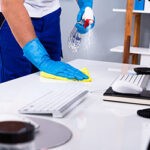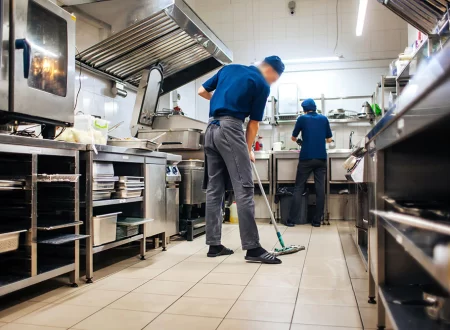
Kitchen floor cleaning is anything but a walk in the park. Not only do you have to contend with stubborn grease, spilled drinks, and food stains, but designers often differentiate restaurant areas using various flooring materials. This means you might find carpet at the front, wood in the bar, sealed concrete in the dining area, and a tile and grout commercial kitchen floor with ceramic tiles. Mismanaging this can result in damage to costly finishes, a tarnished reputation, and financial setbacks. Luckily, Corporate Clean LLC possesses the right equipment, tools, and techniques to make kitchen floor cleaning a swift, thorough, and uncomplicated process.
How to Clean a Kitchen Floor:
1. Kitchen Floor Cleaning – Sweep the Floor:
- Description: Before you start mopping the kitchen floor, ensure the tiles are free of any lingering dirt or debris. In fact, it’s often a good practice to sweep the area two or three times throughout the day, depending on the volume of business and foot traffic.
2. Properly Mix the Cleaning Fluid:
- Description: One common mistake is either overestimating or underestimating the cleaner-to-water ratio when preparing the cleaning fluid. The key is to follow the proportions recommended on the cleaning fluid’s label. Adding extra cleaner won’t result in a shinier floor; it can lead to thin spreading or the formation of drying suds.
3. Apply Cleaning Fluid and Mop:
- Description: With the cleaning solution prepared in a bucket, apply small amounts of it to the areas that need mopping. Dip the mop into the bucket, then wring it out before starting to mop the floor using circular and back-and-forth motions. Spend about a minute on each tile area. Place warning signs to alert others to the wet floor during this process, or restrict access to non-cleaning personnel.
4. Scrub With a Sponge and Let Sit:
- Description: After mopping, take a long-handled sponge and scrub the floor for up to 10 minutes. This helps loosen tougher residues embedded in the tiles. While the cleaning solution is sitting, ensure warning signs are in place to indicate the wet floor, which can be slippery and pose a safety hazard.
5. Wipe, Rinse, and Dry:
- Description: Once the cleaner has had time to set and emulsify grease, use a squeegee to wipe the fluid into floor drains. If available, rinse the floor with hot water, then wipe away the rinse water. In cases where the floor hasn’t been thoroughly cleaned for some time, you may need to repeat the mopping, scrubbing, rinsing, and wiping process up to five times.
How to Keep a Kitchen Floor Clean:
1. Use a Squeegee:
- Description: To combat tough, built-up dirt and grime, a squeegee is your secret weapon. While mops loosen and absorb dirt, a squeegee can remove hard, stubborn residues left behind after initial mopping. A diluted cleaning solution is often needed to emulsify or soften the dirt, making it easier for the squeegee to do its job. At the end of the day, a squeegee can also help remove moisture and leftover mop water from the tiles and guide them into the drains.
2. Clean Once or Twice Daily:
- Description: Daily cleaning is essential for kitchen floors in foodservice establishments, and in some cases, twice-daily cleaning may be necessary. However, more intensive cleaning should occur every four to seven days. Using a 20-inch cleaning device with a scrub pad that rotates at 175 RPM, this process targets tougher, stickier residues that can accumulate despite daily mopping. The cleaner should be wide enough to cover the floor effectively but also narrow enough to reach challenging spots not accessible to mops or squeegees.
3. Keep All Cleaning Devices Properly Stored:
- Description: Proper storage of cleaning devices is crucial for maintaining a sanitary environment. When mops and buckets aren’t stored appropriately, lingering dirt and fluid smells can become aerosolized and spread to more sensitive areas, such as the food preparation area. Cleaning devices must be stored in a designated back room or closet, keeping them away from food and cooking equipment.
4. Commercial Kitchen Floor Cleaning – Use Mats:
- Description: To enhance employee safety after each mopping session, consider covering the walking and standing areas of the kitchen floor with anti-fatigue mats. These mats prevent slips and falls during food prep. Ensure they are cleaned daily and hung up to dry to prevent water absorption.
5. Use Proper Cleaning Formulas:
- Description: Don’t rely on one-size-fits-all cleaning products. Kitchen floors in foodservice establishments, particularly those with quarry tiles, tend to accumulate thicker layers of grease. Opt for high-grade cleaners specially formulated for kitchen floors, as they can effectively tackle these porous surfaces. Avoid general cleaning products that may not provide the desired results. Using unsuitable cleaning agents can make tiles more slippery, which poses safety risks.
A clean kitchen floor is a cornerstone of a hygienic restaurant. While the maintenance may be labor-intensive, particularly in high-traffic establishments, it’s essential for upholding cleanliness and ensuring the safety of your patrons and staff. With the right tools and techniques, kitchen floor cleaning can be a fast, efficient, and effective process. Corporate Clean LLC specializes in providing spotless kitchen floors for various establishments, ensuring your floors remain in top condition. For more information on our cleaning services, visit our services page.
Contact Us: For inquiries, contact us at 713-900-912.




